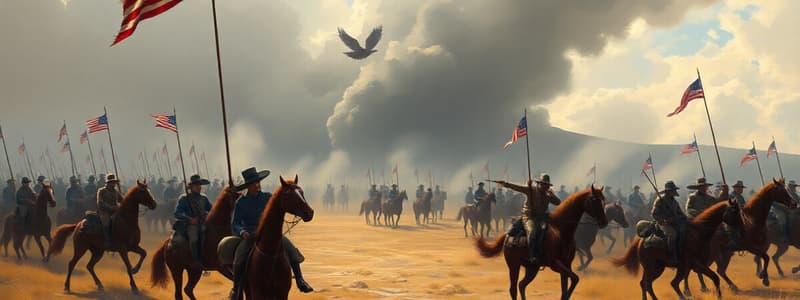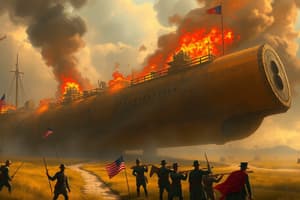Podcast
Questions and Answers
Which event directly led to the secession of Southern states from the Union?
Which event directly led to the secession of Southern states from the Union?
- The formation of the Confederate States of America.
- The Battle of Bull Run.
- The attack on Fort Sumter.
- The election of Abraham Lincoln. (correct)
What was the primary goal of the Anaconda Plan?
What was the primary goal of the Anaconda Plan?
- To negotiate a peaceful resolution with the Confederacy.
- To incite a slave rebellion in the South.
- To quickly invade and conquer Richmond.
- To surround and squeeze the Confederacy into submission. (correct)
Which of the following was a key component of the Anaconda Plan?
Which of the following was a key component of the Anaconda Plan?
- A naval blockade of Confederate ports. (correct)
- Negotiating trade agreements with Europe.
- Immediate emancipation of all slaves.
- Direct military confrontation in Richmond.
Why was General McClellan replaced after the Battle of Antietam?
Why was General McClellan replaced after the Battle of Antietam?
What was the significance of the battle between the USS Monitor and the CSS Virginia?
What was the significance of the battle between the USS Monitor and the CSS Virginia?
What was the main objective of Union forces in Virginia during the Civil War?
What was the main objective of Union forces in Virginia during the Civil War?
Which general was in command of Confederate forces in Missouri?
Which general was in command of Confederate forces in Missouri?
What area of the country does "Trans-Mississippi Theater" refer to?
What area of the country does "Trans-Mississippi Theater" refer to?
Why was control of the Mississippi River important to the Union?
Why was control of the Mississippi River important to the Union?
What was the outcome of the Battle of Antietam?
What was the outcome of the Battle of Antietam?
Flashcards
Anaconda Plan
Anaconda Plan
A plan to surround and squeeze the Confederacy into submission using a naval blockade and control of the Mississippi River.
General George B. McClellan
General George B. McClellan
A Union general who trained a strong army but was hesitant to pursue Confederate troops, leading to his replacement.
The Peninsula Campaign
The Peninsula Campaign
A series of battles in Virginia aimed at capturing the Confederate capital, Richmond.
The Valley Campaign
The Valley Campaign
Signup and view all the flashcards
Battle of Hampton Roads
Battle of Hampton Roads
Signup and view all the flashcards
The Battle of Antietam
The Battle of Antietam
Signup and view all the flashcards
Trans-Mississippi Theater
Trans-Mississippi Theater
Signup and view all the flashcards
General Ulysses S. Grant
General Ulysses S. Grant
Signup and view all the flashcards
Study Notes
- In 1862, the Civil War was in its early stages after Southern states seceded from the Union due to Abraham Lincoln's election and the issue of slavery, forming the Confederate States of America with Jefferson Davis as President.
- The Union possessed an established government, a trained military, better funding, supplies, factories, and manufacturing capabilities, leading many to underestimate the Confederacy's resolve.
- Early Confederate victories, such as the First Battle of Bull Run, demonstrated that the South would not concede easily.
- The Civil War saw significant battles in both Virginia and Missouri.
The Anaconda Plan
- General Winfield Scott's Anaconda Plan aimed to peacefully subdue the Confederacy.
- The Anaconda Plan involved a naval blockade of Confederate ports along the Atlantic Coast and the Gulf of Mexico.
- The Anaconda Plan also wanted to control the Mississippi River to split the Confederate States.
- The Anaconda Plan sought to force Confederate surrender by denying supplies and resources, but some Union generals favored a more aggressive approach.
General George B. McClellan
- General McClellan trained a strong army and achieved early victories, but he often ignored President Lincoln's orders and lacked aggression.
- After the Battle of Antietam Creek, McClellan hesitated to pursue General Lee's retreating forces, leading to his replacement by General Ambrose Burnside.
Civil War Battles in Virginia
- Virginia was a major battleground due to its factories and the location of the Confederate capital, Richmond.
- Over 120 battles were fought in Virginia during the Civil War.
- The Union aimed to capture Richmond, while the Confederacy sought to capture Washington D.C.
The Peninsula Campaign
- General McClellan's attempt to capture Richmond via the Peninsula Campaign was thwarted by his cautious approach and the arrival of Confederate reinforcements.
- McClellan began a time-consuming siege at Yorktown instead of attacking outright.
The Valley Campaign
- General Stonewall Jackson successfully diverted Union attention away from Richmond.
- General Jackson outmaneuvered Union armies in the Shenandoah Valley.
The Battle of Hampton Roads
- The Battle of Hampton Roads was the first clash between ironclad warships, the USS Monitor and CSS Virginia, ending in a stalemate.
- The USS Monitor prevented the Virginia from breaking the Union blockade.
The Second Battle of Bull Run
- General Robert E. Lee crushed Union forces under Maj. Gen. John Pope at the Second Battle of Bull Run.
- After the victory at Bull Run, General Lee advanced across the Potomac River into Union territory.
The Battle of Fredericksburg
- Union General Ambrose E. Burnside's attempt to engage General Lee's troops at Fredericksburg resulted in a Confederate victory.
The Battle of Antietam
- The Battle of Antietam in 1862 was the deadliest one-day battle of the Civil War, ending in a stalemate.
- The Battle of Antietam halted Lee's northward advance and discouraged European recognition of the Confederacy.
Civil War Battles in Missouri
- Missouri, a border state, experienced intense fighting with over 1,000 battles fought there.
- Missouri saw both sides claiming control and establishing separate governments.
- General Sterling Price led Confederate forces using guerilla warfare.
- Major General Henry W. Halleck commanded Union troops.
The Trans-Mississippi Theater
- Control of Missouri was vital for control of the Mississippi River.
- The Mississippi River was crucial for Confederate troop movement, communications, and supplies, with Texas cattle and Louisanna cotton.
- The Trans-Mississippi Theater encompasses battles fought west of the Mississippi River.
- Lincoln aimed to split the Confederacy by controlling the Mississippi River, limiting aid to Richmond and facilitating the capture of New Orleans.
Battle of Shiloh
- Confederate forces attacked Union General Ulysses S. Grant at Shiloh before reinforcements could arrive.
- General Grant's reinforcements arrived quickly, pushing the Confederate forces into retreat.
The Battle of Kirksville
- Union Colonel John McNeil defeated Confederate Colonel Joseph C. Porter, securing Union control of northeastern Missouri.
The Battle of Compton's Ferry and Yellow Creek
- Union Colonel Odon Guitar routed Confederate Colonel John A. Poindexter at Compton Ferry, seizing ammunition and supplies.
- Guitar pursued the Confederate forces to Yellow Creek and wiped them out.
Studying That Suits You
Use AI to generate personalized quizzes and flashcards to suit your learning preferences.




